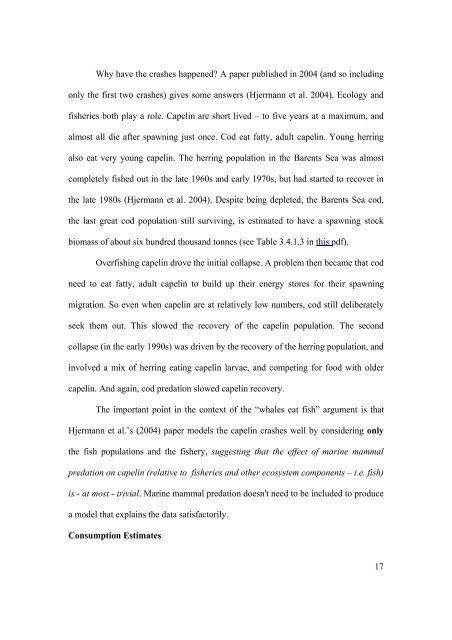ICELAND, - Whale and Dolphin Conservation Society
ICELAND, - Whale and Dolphin Conservation Society
ICELAND, - Whale and Dolphin Conservation Society
You also want an ePaper? Increase the reach of your titles
YUMPU automatically turns print PDFs into web optimized ePapers that Google loves.
Why have the crashes happened A paper published in 2004 (<strong>and</strong> so including<br />
only the first two crashes) gives some answers (Hjermann et al. 2004). Ecology <strong>and</strong><br />
fisheries both play a role. Capelin are short lived – to five years at a maximum, <strong>and</strong><br />
almost all die after spawning just once. Cod eat fatty, adult capelin. Young herring<br />
also eat very young capelin. The herring population in the Barents Sea was almost<br />
completely fished out in the late 1960s <strong>and</strong> early 1970s, but had started to recover in<br />
the late 1980s (Hjermann et al. 2004). Despite being depleted, the Barents Sea cod,<br />
the last great cod population still surviving, is estimated to have a spawning stock<br />
biomass of about six hundred thous<strong>and</strong> tonnes (see Table 3.4.1.3 in this pdf).<br />
Overfishing capelin drove the initial collapse. A problem then became that cod<br />
need to eat fatty, adult capelin to build up their energy stores for their spawning<br />
migration. So even when capelin are at relatively low numbers, cod still deliberately<br />
seek them out. This slowed the recovery of the capelin population. The second<br />
collapse (in the early 1990s) was driven by the recovery of the herring population, <strong>and</strong><br />
involved a mix of herring eating capelin larvae, <strong>and</strong> competing for food with older<br />
capelin. And again, cod predation slowed capelin recovery.<br />
The important point in the context of the “whales eat fish” argument is that<br />
Hjermann et al.’s (2004) paper models the capelin crashes well by considering only<br />
the fish populations <strong>and</strong> the fishery, suggesting that the effect of marine mammal<br />
predation on capelin (relative to fisheries <strong>and</strong> other ecosystem components – i.e. fish)<br />
is - at most - trivial. Marine mammal predation doesn't need to be included to produce<br />
a model that explains the data satisfactorily.<br />
Consumption Estimates<br />
17
















